#witch trials
Text
A lot of people on here don’t seem to realise that the witch trials that happened in Europe in the Early Modern period aren’t some vague legendary events to carelessly use as an allegory or feminist/Wicca/witchy martyr myth. Real women AND MEN, many of whom are named and known, died in these events. They may have been executed for witchcraft, but often this had nothing to do with a folk practice, and more to do with social, political and ethnic tensions.
These victims are no one’s to claim as martyrs. Their deaths are communal tragedies that drastically reshaped the social fabric of many places and hold an important place in folklore traditions and local identities up to this day.
Please stop appropriating these events, claiming the dead as yours without care for the local context in which they lived and died. A lineage lives locally that is not yours to take. Have some respect.
613 notes
·
View notes
Text






JSTOR Articles on the History of Witchcraft, Witch Trials, and Folk Magic Beliefs
This is a partial of of articles on these subjects that can be found in the JSTOR archives. This is not exhaustive - this is just the portion I've saved for my own studies (I've read and referenced about a third of them so far) and I encourage readers and researchers to do their own digging. I recommend the articles by Ronald Hutton, Owen Davies, Mary Beth Norton, Malcolm Gaskill, Michael D. Bailey, and Willem de Blecourt as a place to start.
If you don't have personal access to JSTOR, you may be able to access the archive through your local library, university, museum, or historical society.
Full text list of titles below the cut:
'Hatcht up in Villanie and Witchcraft': Historical, Fiction, and Fantastical Recuperations of the Witch Child, by Chloe Buckley
'I Would Have Eaten You Too': Werewolf Legends in the Flemish, Dutch and German Area, by Willem de Blecourt
'The Divels Special Instruments': Women and Witchcraft before the Great Witch-hunt, by Karen Jones and Michael Zell
'The Root is Hidden and the Material Uncertain': The Challenges of Prosecuting Witchcraft in Early Modern Venice, by Jonathan Seitz
'Your Wife Will Be Your Biggest Accuser': Reinforcing Codes of Manhood at New England Witch Trials, by Richard Godbeer
A Family Matter: The CAse of a Witch Family in an 18th-Century Volhynian Town, by Kateryna Dysa
A Note on the Survival of Popular Christian Magic, by Peter Rushton
A Note on the Witch-Familiar in Seventeenth Century England, by F.H. Amphlett Micklewright
African Ideas of Witchcraft, by E.G. Parrinder
Aprodisiacs, Charms, and Philtres, by Eleanor Long
Charmers and Charming in England and Wales from the Eighteenth to the Twentieth Century, by Owen Davies
Charming Witches: The 'Old Religion' and the Pendle Trial, by Diane Purkiss
Demonology and Medicine in the Sixteenth and Seventeenth Centuries, by Sona Rosa Burstein
Denver Tries A Witch, by Margaret M. Oyler
Devil's Stones and Midnight Rites: Megaliths, Folklore, and Contemporary Pagan Witchcraft, by Ethan Doyle White
Edmund Jones and the Pwcca'r Trwyn, by Adam N. Coward
Essex County Witchcraft, by Mary Beth Norton
From Sorcery to Witchcraft: Clerical Conceptions of Magic in the Later Middle Ages, by Michael D. Bailey
German Witchcraft, by C. Grant Loomis
Getting of Elves: Healing, Witchcraft and Fairies in the Scottish Witchcraft Trials, by Alaric Hall
Ghost and Witch in the Sixteenth and Seventeenth Centuries, by Gillian Bennett
Ghosts in Mirrors: Reflections of the Self, by Elizabeth Tucker
Healing Charms in Use in England and Wales 1700-1950, by Owen Davies
How Pagan Were Medieval English Peasants?, by Ronald Hutton
Invisible Men: The Historian and the Male Witch, by Lara Apps and Andrew Gow
Johannes Junius: Bamberg's Famous Male Witch, by Lara Apps and Andrew Gow
Knots and Knot Lore, by Cyrus L. Day
Learned Credulity in Gianfrancesco Pico's Strix, by Walter Stephens
Literally Unthinkable: Demonological Descriptions of Male Witches, by Lara Apps and Andrew Gow
Magical Beliefs and Practices in Old Bulgaria, by Louis Petroff
Maleficent Witchcraft in Britian since 1900, by Thomas Waters
Masculinity and Male Witches in Old and New England, 1593-1680, by E.J. Kent
Methodism, the Clergy, and the Popular Belief in Witchcraft and Magic, by Owen Davies
Modern Pagan Festivals: A Study in the Nature of Tradition, by Ronald Hutton
Monstrous Theories: Werewolves and the Abuse of History, by Willem de Blecourt
Neapolitan Witchcraft, by J.B. Andrews and James G. Frazer
New England's Other Witch-Hunt: The Hartford Witch-Hunt of the 1660s and Changing Patterns in Witchcraft Prosecution, by Walter Woodward
Newspapers and the Popular Belief in Witchcraft and Magic in the Modern Period, by Owen Davies
Occult Influence, Free Will, and Medical Authority in the Old Bailey, circa 1860-1910, by Karl Bell
Paganism and Polemic: The Debate over the Origins of Modern Pagan Witchcraft, by Ronald Hutton
Plants, Livestock Losses and Witchcraft Accusations in Tudor and Stuart England, by Sally Hickey
Polychronican: Witchcraft History and Children, interpreting England's Biggest Witch Trial, 1612, by Robert Poole
Publishing for the Masses: Early Modern English Witchcraft Pamphlets, by Carla Suhr
Rethinking with Demons: The Campaign against Superstition in Late Medieval and Early Modern Europe from a Cognitive Perspective, by Andrew Keitt
Seasonal Festivity in Late Medieval England, Some Further Reflections, by Ronald Hutton
Secondary Targets: Male Witches on Trial, by Lara Apps and Andrew Gow
Some Notes on Modern Somerset Witch-Lore, by R.L. Tongue
Some Notes on the History and Practice of Witchcraft in the Eastern Counties, by L.F. Newman
Some Seventeenth-Century Books of Magic, by K.M. Briggs
Stones and Spirits, by Jane P. Davidson and Christopher John Duffin
Superstitions, Magic, and Witchcraft, by Jeffrey R. Watt
The 1850s Prosecution of Gerasim Fedotov for Witchcraft, by Christine D. Worobec
The Catholic Salem: How the Devil Destroyed a Saint's Parish (Mattaincourt, 1627-31), by William Monter
The Celtic Tarot and the Secret Tradition: A Study in Modern Legend Making, by Juliette Wood
The Cult of Seely Wights in Scotland, by Julian Goodare
The Decline of Magic: Challenge and Response in Early Enlightenment England, by Michael Hunter
The Devil-Worshippers at the Prom: Rumor-Panic as Therapeutic Magic, by Bill Ellis
The Devil's Pact: Diabolic Writing and Oral Tradition, by Kimberly Ball
The Discovery of Witches: Matthew Hopkins' Defense of his Witch-hunting Methods, by Sheilagh Ilona O'Brien
The Disenchantment of Magic: Spells, Charms, and Superstition in Early European Witchcraft Literature, by Michael D. Bailey
The Epistemology of Sexual Trauma in Witches' Sabbaths, Satanic Ritual Abuse, and Alien Abduction Narratives, by Joseph Laycock
The European Witchcraft Debate and the Dutch Variant, by Marijke Gijswijt-Hofstra
The Flying Phallus and the Laughing Inquisitor: Penis Theft in the Malleus Maleficarum, by Moira Smith
The Framework for Scottish Witch-Hunting for the 1590s, by Julian Goodare
The Imposture of Witchcraft, by Rossell Hope Robbins
The Last Witch of England, by J.B. Kingsbury
The Late Lancashire Witches: The Girls Next Door, by Meg Pearson
The Malefic Unconscious: Gender, Genre, and History in Early Antebellum Witchcraft Narratives, by Lisa M. Vetere
The Mingling of Fairy and Witch Beliefs in Sixteenth and Seventeenth Century Scotland, by J.A. MacCulloch
The Nightmare Experience, Sleep Paralysis, and Witchcraft Accusations, by Owen Davies
The Pursuit of Reality: Recent Research into the History of Witchcraft, by Malcolm Gaskill
The Reception of Reginald Scot's Discovery of Witchcraft: Witchcraft, Magic, and Radical Religions, by S.F. Davies
The Role of Gender in Accusations of Witchcraft: The Case of Eastern Slovenia, by Mirjam Mencej
The Scottish Witchcraft Act, by Julian Goodare
The Werewolves of Livonia: Lycanthropy and Shape-Changing in Scholarly Texts, 1550-1720, by Stefan Donecker
The Wild Hunter and the Witches' Sabbath, by Ronald Hutton
The Winter Goddess: Percht, Holda, and Related Figures, by Lotta Motz
The Witch's Familiar and the Fairy in Early Modern England and Scotland, by Emma Wilby
The Witches of Canewdon, by Eric Maple
The Witches of Dengie, by Eric Maple
The Witches' Flying and the Spanish Inquisitors, or How to Explain Away the Impossible, by Gustav Henningsen
To Accommodate the Earthly Kingdom to Divine Will: Official and Nonconformist Definitions of Witchcraft in England, by Agustin Mendez
Unwitching: The Social and Magical Practice in Traditional European Communities, by Mirjam Mencej
Urbanization and the Decline of Witchcraft: An Examination of London, by Owen Davies
Weather, Prayer, and Magical Jugs, by Ralph Merrifield
Witchcraft and Evidence in Early Modern England, by Malcolm Gaskill
Witchcraft and Magic in the Elizabethan Drama by H.W. Herrington
Witchcraft and Magic in the Rochford Hundred, by Eric Maple
Witchcraft and Old Women in Early Modern Germany, by Alison Rowlands
Witchcraft and Sexual Knowledge in Early Modern England, by Julia M. Garrett
Witchcraft and Silence in Guillaume Cazaux's 'The Mass of Saint Secaire', by William G. Pooley
Witchcraft and the Early Modern Imagination, by Robin Briggs
Witchcraft and the Western Imagination by Lyndal Roper
Witchcraft Belief and Trals in Early Modern Ireland, by Andrew Sneddon
Witchcraft Deaths, by Mimi Clar
Witchcraft Fears and Psychosocial Factors in Disease, by Edward Bever
Witchcraft for Sale, by T.M. Pearce
Witchcraft in Denmark, by Gustav Henningsen
Witchcraft in Germany, by Taras Lukach
Witchcraft in Kilkenny, by T. Crofton Croker
Witchcraft in Anglo-American Colonies, by Mary Beth Norton
Witchcraft in the Central Balkans I: Characteristics of Witches, by T.P. Vukanovic
Witchcraft in the Central Balkans II: Protection Against Witches, by T.P. Vukanovic
Witchcraft Justice and Human Rights in Africa, Cases from Malawi, by Adam Ashforth
Witchcraft Magic and Spirits on the Border of Pennsylvania and West Virginia, by S.P. Bayard
Witchcraft Persecutions in the Post-Craze Era: The Case of Ann Izzard of Great Paxton, 1808, by Stephen A. Mitchell
Witchcraft Prosecutions and the Decline of Magic, by Edward Bever
Witchcraft, by Ray B. Browne
Witchcraft, Poison, Law, and Atlantic Slavery, by Diana Paton
Witchcraft, Politics, and Memory in Seventeeth-Century England, by Malcolm Gaskill
Witchcraft, Spirit Possession and Heresy, by Lucy Mair
Witchcraft, Women's Honour and Customary Law in Early Modern Wales, by Sally Parkin
Witches and Witchbusters, by Jacqueline Simpson
Witches, Cunning Folk, and Competition in Denmark, by Timothy R. Tangherlini
Witches' Herbs on Trial, by Michael Ostling
#witchcraft#witchblr#history#history of witchcraft#occult#witch trials#research#recommended reading#book recs#jstor
2K notes
·
View notes
Text
SONIC HOCUS POCUS AU!!
"In wich Metal, Amy and Sage have to stop the curse of the Sanderson Witches before accidentally causing said curse in halloween night."
//TW: mild-mentions to death, violence, and gore//


Metal and Sage are new in the city of Salem, with their fathers (Ivo and Stone) moving out into an old family house that an relative of Ivo Kintobor left to his name.
Amy is your local believer of all stuff paranormal and most importantly: the history of Salem, even being long-time friends with Tails, who is an all and all recognizable kid for being an allegedly descendant of The Sanderson Sisters. He doesn't seem to like how much attention he get's about it tho...
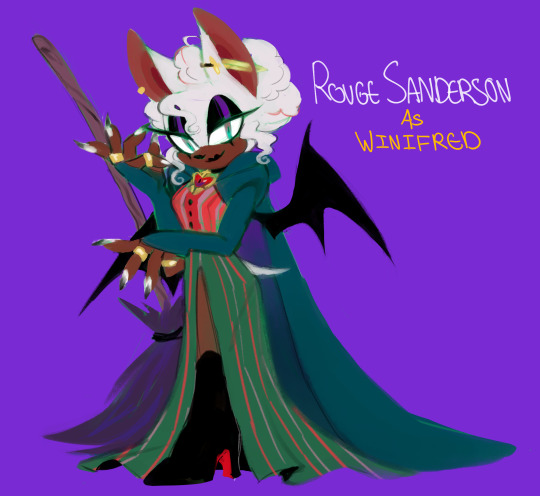


Rouge, Sonic and Honey a.k.a: The Sanderson Sisters
Are the most famous names of the whole town,having been said to be the main inquisitors of spreding havoc and misfortune with witchery in Salem centuries ago:
-Rouge Sanderson, the oldest and most powerful of the three. She possessed a spell-book that was bound in human skin and contained her most powerful spells and recipes.
-Nicky Sanderson (Better known as Sonic) that was a charming but deeply dangerous witch, with a voice that could control and lure the mind of anyone that heard him. Rumors said his own magic slowly brought him into madness.
-Honey Sanderson, a seamstress of enchanted puppets for curses and spells. Those who got tempted by revenge usually came to her and payed a big price for her terrible practices to control others.


A lot of stories has been told around the years about the acts of the witches, such as the one of Knuckles E.: Rouge's lover, who was said to mingle with Sonic, so she poisoned the echidna and got Honey sew his mouth, so he couldn't tell Rouge's secrets even in death.
But, by far the most well-known story, is the one of how the three witches where hanged. Having plans of taking the life of childrens to aquire everlasting life.
Legend says, that they did indeed took the soul of one Maria Kintobor, as a way to punish the whole Kintobor lineage for their persecutions against themselves, as the head of the family, Gerald Kintobor, was the main judge in charge of witches law by that time.
The oldest brother of the family, Shadow Kintobor, was lost to this as well, cursed to live forever in the form of a black cat that guarded the only thing that could bring the Witches back: The Black Flame Candle.
STAY TUNED FOR MORE...!
#sth#sonic the hedgehog#sonic au#au#sonic hocus pocus au#witches#spells#based on the 1993 movie#witch trials#metal sonic#amy rose#sage#miles tails prower#rouge the bat#honey the cat#knuckles the echidna#shadow the hedgehog#halloween#TW#mild horror#but like#fun <3#Murder#morbid jokes#They are slaying tho
273 notes
·
View notes
Text
Hot take: the Wittebanes were not Puritans
So since Hollow Mind came out there have been a lot of jokes about how the Belos is a crusty old Puritan. And while he is certainly crusty and old, I don’t think he was a Puritan.
I understand why everyone jumps there, when we think of Witch Hunts in Colonial America the very first thing that comes to mind is the Salem Witchcraft Trials. However, the Salem Witchcraft Trials began in 1692, that is 80 years after Masha says the Wittebros showed up in Gravesfield, and 30 years after the events of Elsewhere and Elsewhen.

If Masha’s information is correct, (which it might not be but we’ll get to that) then Caleb and Philip arrived in Gravesfield in 1613, which is closer in time to the settlement of Jamestown (1607) than the Salem Witchcraft Trials.
The Pilgrims didn’t even land at pride rock until 1620, seven years after the Wittebros arrived in Gravesfield. The Mayflower Pilgrims were really the group responsible for creating the idea of religious charters. They specifically wanted to leave England to create their own religious society. Many other groups followed, (notably the Massachusetts Bay Colony, which later became the home of the aforementioned Salem Witchcraft Trials) but the Mayflower Pilgrims were the first group of religious extremists who came to America looking for their Zion.
Prior to that, the motivation to settle the “New World” was mainly financial. Ships were chartered through the Virginia Company. Which as we all remember from our favorite wildly inaccurate and problematic 90s Disney movie, the Virginia Company was in it for the money. The New World had resources and Britian wanted them, damnit, Glory, God, and Gold and the Virginia Company.
That meant, if Caleb and Philip really did arrive in Gravesfield in 1613, their family likely made the trip for financial gain, not religion. If that’s the case they were less likely a member of an obscure group of religious extremists, and more likely to be either Protestant like King James and Queen Elizabeth. (They could have also been Roman Catholic, evidence for that comes later).
“But”, you say, “weren’t Puritans the ones persecuting witches at the time?”
Yes and no.
In the Americas, Witch Hunts will forever be linked to Puritans, but in Witch Hunting long outdates the Puritans. King James himself, was a witch hunting fanatic, he personally oversaw hundreds of witchtrials. He wrote books about finding witches, and it was specifically the King James endorse translation of the Bible that features the infamous “thou shalt not suffer a witch to live” (in many prior translations the word witch is something more along the line of “sinner” or “evil doer”). By many estimates, upwards of 1500 people were executed for witchcraft as a result of his reign. If we are going with Masha’s 1613 timeline, the brothers would have left England smack dab in the middle of his reign, right after the King James Bible was published.

(^this GIF has nothing to do with the Owl House, I just love sassy Gay King James in his bird mask, look at this cocky ass bastard, you know him and Belos would have been genocide buddies)
However, I can’t pretend to be focused on some semblance of historical accuracy and take Masha’s information at face value, even in the context of the show it wouldn’t add up because according to the sign we see in Yesterday’s Lie, Gravesfield was established in 1635.
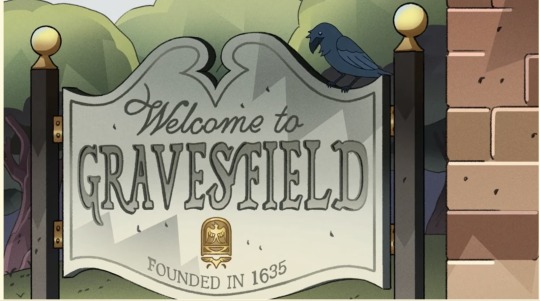
(Granted there is a difference between a settlement and a town, it is possible that 1635 was when Gravesfield was officially acknowledged as a town and the boys just lived there pre-establishment).
However, in the name of historical accuracy, I have to assume Masha got the date wrong, because the English didn’t even settle in Conneticut until the 1630s. The Conneticut Witch Trials began in the 1640s. By this timeline and demographic, the likelihood of Caleb and Philip being Puritans goes up by a lot.
However, if we look at Philip’s clothes an his goals, there are still signs that don’t point to Puritanism. First look at the clothes Caleb and Philip wear as children:
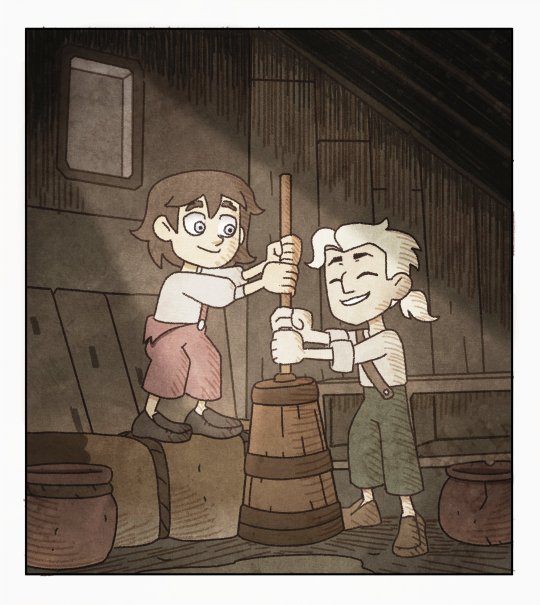
Philip’s pants are red and Calebs are green. While it is a myth that Puritans could only wear black, the colors that they were allowed to incorporate into their wardrobe were typically still neutrals (dark yellows and beiges). Green would be pushing it, and red would be unbelievably bold.

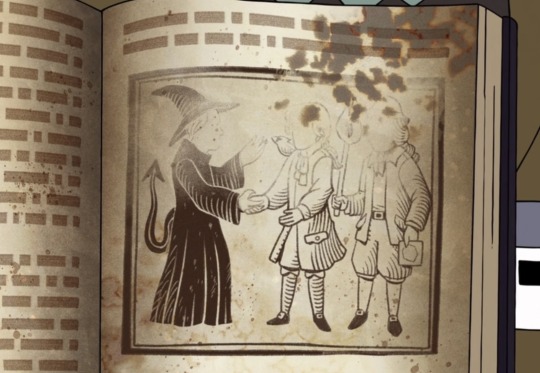
Additionally, the ruffles on Philip’s shirt in the journal and Jacob’s book, would have been seen as incredibly vain.



The blue/black coat that Caleb wore in the puppet show, and Philip later wears in Elsewhere and Elsewhen and King’s Tide has gold buttons and gold embroidery. Gold and Silver accessories of any kind would have been considered incredibly sinful and conceited.
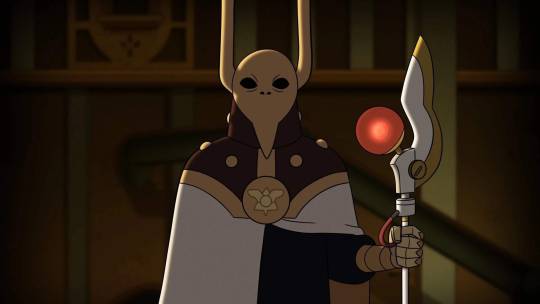
Which would also make it really weird for a Puritan to choose gold to represent himself. Infact his whole emperor authentic is much more reminiscent of the Catholic Pope. His own role as the messenger of the Titan’s will is also very papal in nature.
Finally there is the term he uses, “Witch Hunter General” is an illusion to “Witch Finder General” which was a rank made up and used by Protestant Matthew Hopkins and not really used by any Puritans. Such a title would also probably have seemed pretty vain.
Now you might say, “It’s a fictional story, why does any of this matter?”
The answer is: It does not, but I am high and have ADHD and this was the rabbit hole I fell down.
#the owl house#owl house#toh#wittebros#wittebane brothers#philip wittebane#caleb wittebane#witch trials#witch hunts#history#belos#emperor belos
573 notes
·
View notes
Text
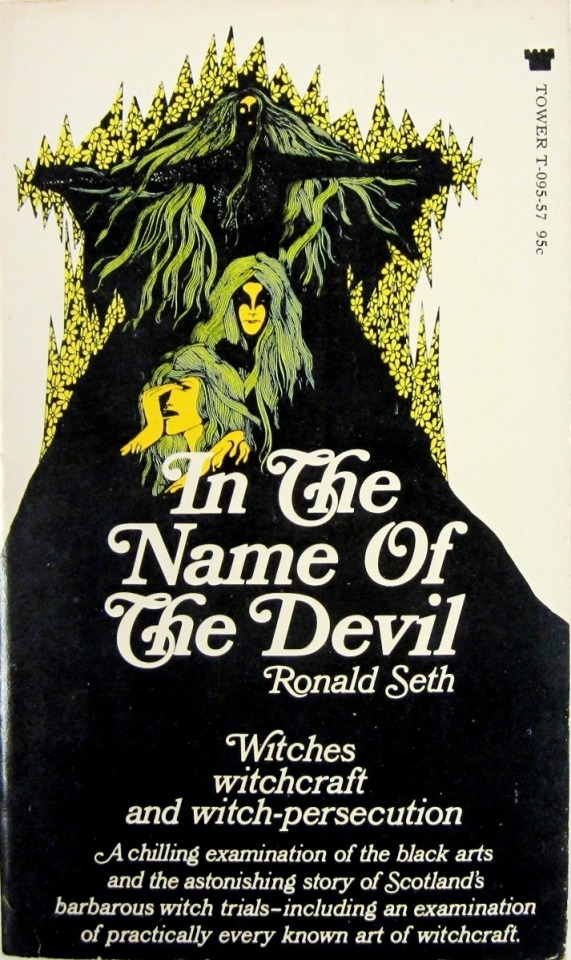
Ronald Seth - In The Name Of The Devil - Tower - 1969
#witches#witchfinders#occult#vintage#in the name of the devil#name#devil#persecution#tower books#scotland#witch trials#ronald seth#1969
197 notes
·
View notes
Text
I love this. I posted a little about this before, but wanted to expand. Women's history fact of the day:
Women of the Neolithic era in particular loved keeping pets and it was common for them to trap small animals - such as cats - and adopted as pets.
In the Amazon region, where hunting and gathering and subsistence horticulture is still practiced by a handful of surviving Amerindian groups, hunters commonly capture young wild animals and take them home where they are then adopted as pets, usually – although not invariably – by women.
There's a theory that cats may have domesticated themselves by being attracted to human villages that produced grain and seeds and attracted rodents, and then the bolder cat clans survived under natural selection. Or, alternatively, women domesticated cats.
Based on these sorts of observations, it could be argued that the domestication of F.s. libyca occurred where and when it did because tamed wildcats were already an integral feature of village life as a result of people actively adopting, hand-rearing and socialising young wildcats to keep as pets
The relationship between cats and women stretch back since the stone age. They were burned with us during the witch trials (rabbits commonly too!), suffered from abuse and treated as property with us by men ambivalent to us under religions such as Christianity, were associated as us within medieval folklore and as a metaphor for female sexuality and anatomy ("pussy"), and continue to be associated with us today.

Women's independence from man is derogatorily associated with cats ("crazy cat lady"), a nod to female (and feline) separatism. It's tendency to groom itself frequently was also associated with cleanliness and domesticity, and it was frequently used in posters by anti-suffragettes symbolically to denote that women were simple and delicate, that women's suffrage was as absurd as cat suffrage. Some suffragettes took back the meaning of the cat, adopting a (black!) cat named Saxon as their official mascot.

They survived male oppression throughout history, for thousands of years, right beside us and within our arms.
#cats#cat appreciation post#cat history#women's history#women and cats#kitties#witch trials#witchcraft#human history#evolution
514 notes
·
View notes
Photo

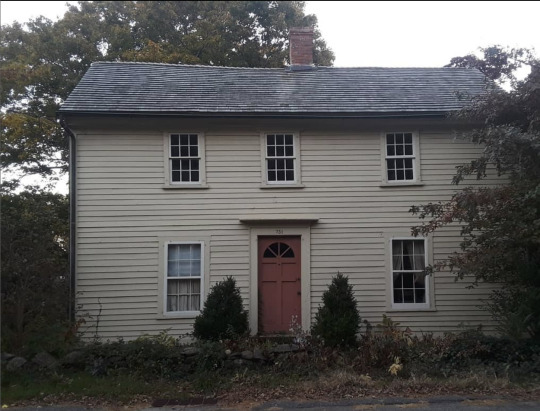

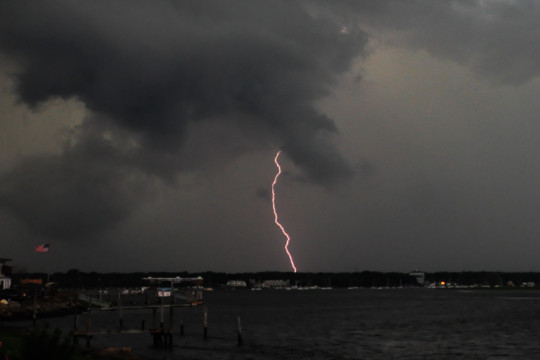



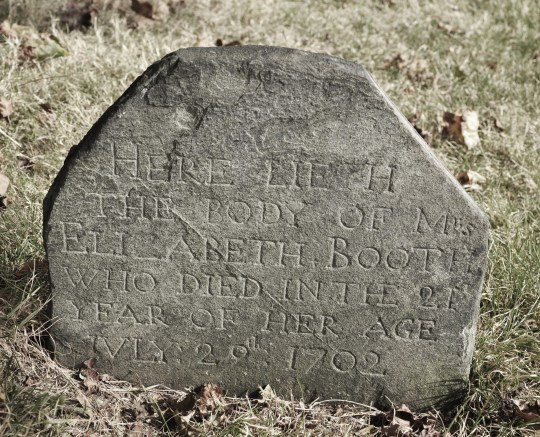


Coastal New England Gothic: Stratford, CT, founded 1639. Site of the hanging of Goody Bassett for witchcraft in 1651
photos from flickr
#long island sound#gothic#new england gothic#coastal new england#new england#aesthetic#new england aesthetic#halloween#coastal new england gothic#spooky#witch trials#storms#stratford#connecticut#connecticut gothic
2K notes
·
View notes
Text









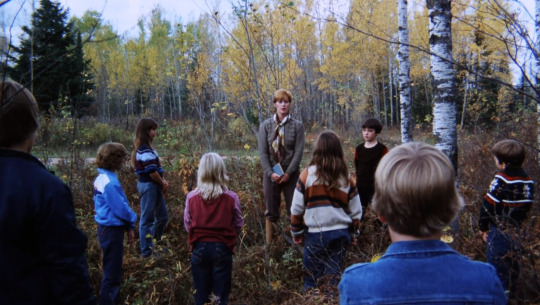




The Devonsville Terror (1983)
#the devonsville terror#my posts#horror#horror movies#ulli lommel#suzanna love#witches#witchcraft#witch movies#witch#1980s horror#80s horror#film#movies#horror stills#movie caps#horrorcaps#feminist horror#cult movies#cult film#witch trials#grindhouse#supernatural#salem witch trials#horror community#satanic worship#satan#horroredit
108 notes
·
View notes
Text



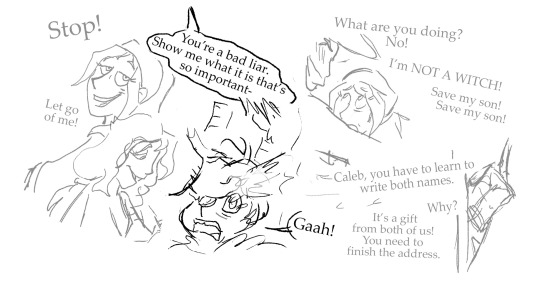
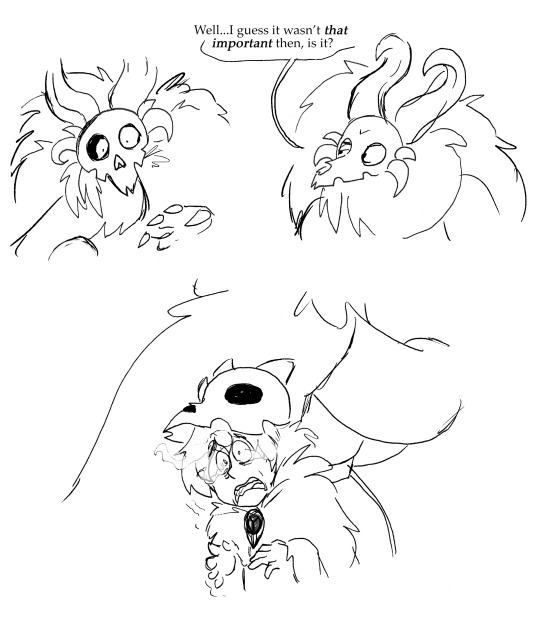

Eve and the Witnits - Eye on You
>tmw I accidentally saw my mom's graphic death and realized everyone hated me while I was still 9. Good times.
Mad Gorey could see his thoughts because she was keen to oracle magic.
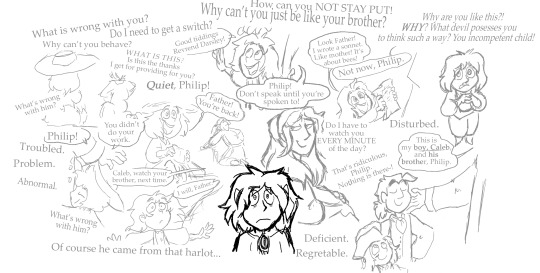
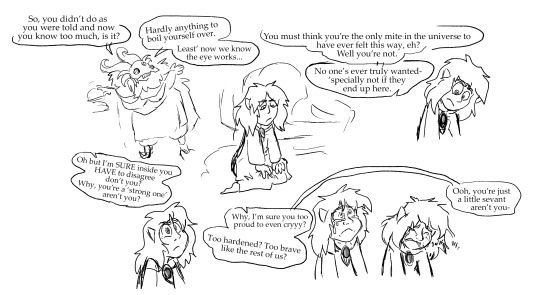




#my art#franki lew#artists on tumblr#puritans#witch trials#salem witch trials#the owl house#the owl house au#toh au#toh comic#toh aus#philip wittebane#wittebane brothers#wittebros#emperor belos#titan trappers#cw: abuse
54 notes
·
View notes
Text
And when I say 1700s, I’m being REALLY generous. Hell, while interest in the “pagan religions” (because that’s a catch all term for a LOT of religions) really blew up during the late Victorian spiritualism craze, modern Wicca and Paganism really started 1930s at earliest and gained a hell of a lot of ground in the 50s & 70s.
Sandman’s start date (the comics at least) are based on that boom in the 30s mentioning Alistair Crowley.
Your religion isn’t new and that’s not a bad thing. All religions have to start somewhere. But don’t cosplay other people’s persecution, ok?
471 notes
·
View notes
Text
Something a lot of people don't really understand today is that the people blaming witches for misfortune back in the days of the witch panic were basically the conspiracy theorists of their time. People didn't blame witches just because they just didn't understand how disease or whatever worked. There were plenty of explanations that didn't involve witches; EG, disease could be explained through things like miasma, imbalanced humors, and malefic stellar influences. They blamed witches because they believed in conspiracy theories about witches.
#history#witch panic#witchcraft#conspiracy theories#conspiracism#conspiracy theorists#witch hunts#witch trials
88 notes
·
View notes
Text
This Nonsense again:

I just can't get how People can think that saying "Actually those Victims of Persecution weren't killed senselessly, there actually was a real Reason on their Part for it" is even remotely an empowering Take.
People need to understand that the Victims and Targets of the Witch Trials were innocent¹ People and none of them were Witches, especially not in that modern, pop-feminist Way² People like to see them. You rob yourself of crucial Insights to understand most historical Persecutions, if you don't accept that very often those solely founded on Conspiracy Theories, Mass Hysteria and coerced Confessions.
Acting like the Victims of those were actually what their Persecutors thought them to be (but in ~cool~) is just disrespectful and relativizes their Suffering, as it in a Way posthumously justifies it.
So, no. They don't burned them (them, not "you"³) for being some cool empowered Proto-Feminists, but out of Superstition, Begrudgery and Greed and most importantly, because they could get away with it.
1 I don't have the Topic present enough to say for certain that no Victim actually did the Harm they were accused for, but they definitely didn't do it by Witchcraft.
2 Ironically the Image of the Witch as this empowered, independent Woman with secret Knowledge scorned by the Church that is so popular today was very much shaped by Heinrich Himmler (of "Head of the SS in Nazi-Germany"-Fame).
3 It honestly is just ridiculous to act like there is any shared Community specifically between modern self-identified Witches and those People who were persecuted and murdered as such, once again pure Disrespect for them.
163 notes
·
View notes
Note
hi! i was reading that post on things that need to stop in witchy/spiritual spaces and i was wondering what you meant by the burning times (spelled tymez)? i truly have no idea what this is and sometimes humor goes over my head. thanks!
Oh, my WHEELHOUSE! -claps on the Witchstorian hat-
The Burning Times is a revisionist bit of historical fiction passed around and promoted by the modern witchcraft and pagan communities. It refers to a very real period in European history in the 15th-17th centuries when witch hunts and witch trials were happening frequently, many ending in the hanging or burning of the accused. The revisionist myth seeks to turn these innocents into martyrs, labeling them as members of a secret underground pagan cult that survived the Christianization of Europe and were later hunted by the Church for their attempts to keep a pre-Christian nature-based religion alive. Estimates put forth by some community figures, most notably Gerald Gardner, total the supposed number of slain witches as close to nine million.
In reality, while these trials certainly happened, the accused witches were almost entirely marginalized or disenfranchised persons, targets of vicious gossip and hearsay, or victims of political and ecclesiastical machinations beyond their control. Some were on the wrong side of disagreements between Church factions. Others were Jews, Muslims, or Roma persecuted by a prejudiced and easily frightened populace. And by that point in history, it is safe to say that while pre-Christian trappings certainly remained part of various seasonal festivals and popular superstitions, none of the people accused, arrested, or executed in witch trials were actually pagans.
Nor would they have labeled themselves as witches, despite what our modern standards may make of their practices and beliefs about the world they lived in. It's important to remember that "witch," up until the early 20th century was universally regarded as a derogatory term rather than an empowering one. It is still a derogatory and even dangerous thing to be called in many parts of the world today, despite efforts to reclaim it by the modern witchcraft movement.
(It should be noted that accused persons who confessed to being witches often did so under duress or torture, and it should go without saying that this does not constitute any kind of objective truth.)
Furthermore, the figure of Nine Million Witches is factually impossible in historic terms. With the continent already ravaged by war, famine, plague, and political upset during the 200 or so years that make up the so-called Burning Times, a loss of nine million people from witch trials alone (nearly all of them women, if Gardner is to be believed) would have completely decimated the population of Europe. The Black Death alone killed at least a third of the population less than a century before the first spate of these trials began and the continent wouldn't recover for another 150 years. Simply put, even with the most dedicated and zealous of witch hunters on the case, there wouldn't have been enough people to burn.
The actual number of witch trial victims is closer to about 100,000 all told. That's just what we can prove on paper. And even that made a huge impact. The real figures are enough of a tragedy on their own. No embellishment needed.
The Burning Times was adopted as both a pagan and a feminist buzzword for the patriarchal crimes of the Church, and a documentary film (riddled with factual errors) premiered in 1990 which spread the story to a wider audience and cemented the presence of the myth in the second wave of the New Age and witchcraft reconstructionist movements.
There have been many revelatory texts written by both pagan and secular scholars over the years which debunk the idea of the Burning Times, but it's so firmly entrenched, particularly in popular books by the likes of Buckland and Ravenwolf, that you still see it crop up from time to time. It's one of the things we often have to unteach newer witches and pagans, especially the ones who have an axe to grind.
When we say, "Oh they probably still believe in the Burning Times," with a bit of an eyeroll or a knowing look, it often signifies in a gently derivative way that the person is question is either new to the conversation and has not yet been disabused of certain outdated notions, or that they're clinging to those notions with a tenacity of cognitive dissonance too strong to be countered by common sense.
If you'd like more information on witch trials, I did a very long episode on the history of witchcraft and the law on Hex Positive back in September of 2021, tracing the evolution of witchcraft-related laws and notable trials from the Code of Hammurabi to the late 20th century. The Burning Times myth makes an inevitable appearance during the discussion.
Hope this cleared things up for you! 😁
#kerrigor#witchblr#witch trials#history#history of witchcraft#Hex Positive#Bree answers your inquiries
2K notes
·
View notes
Text
"Never watch another woman burn. Know that love is the only answer."
"Drink lavender tea when you can not sleep. Know that the only remedy for love is to love more."
"Plant roses and lavender for luck. Fall in love whenever you can."
—The endings of Magic Lessons, The Rules of Magic and Practical Magic, books 1 to 3 of the four part Practical Magic series by Alice Hoffman.
#alice hoffman#magic lessons#the rules of magic#practical magic#the book of magic#witches#bloodline witches#curse#owenses#love#romance#familiars#book quotes#bibliophile#books#books for life#nameless art#witch trials
234 notes
·
View notes
Text
The inability to except that Christians can, have, and do practice magic is more "Burning Times" bias and bullshit.
I personally think that some of you prefer the fantasy-esque style narrative of the witch trials; a people of a noble and nature centric belief system being systematically hunted down and killed by an evil empire. As opposed to the reality based narrative of the gender, race, and politcal struggle the witch trials actually represented.
How many times does it have to be said that a large part of the people killed identified as Christian? How many times does it have to be said that many of them weren't practicing anything?
Not Midwifery. Not Herbalism. Not Cunning Craft.
Nothing.
Some were accused simply for the sake of accusation. Accusation that could be used as a tool to exert political and religious power- or accusation simply because of unchecked panic and fear. Sometimes both.
If there is a generalized lesson one can take from the complexities of the witch trials, it's not "Witches were oppressed and killed by the church" but rather "The church and other political elites created a bogeyman so generic and pervasive in the psyche of the people they were meant to govern that people died, many of whom were "their own"."
It was a time and place in history where almost none were safe, and I personally think that's something we should unite under. Not use as a wedge to further drive us apart- or a means to label oneself as a "true heir" to witchcraft/magic while labeling others as "natural enemies" (like seriously, that's how some of you act and...yuck.)
#not christian#just like history#rant#magic#folk magic#spirituality#folklore#magic practitioners#ritual magic#witchblr#witchcraft#history#dialog#witch trials#witch hunts#'burning times'
451 notes
·
View notes
Text
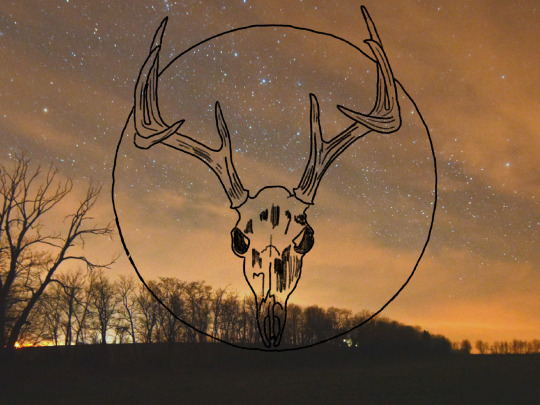
Like the Witch Father, the Witch Mother is the dual-natured Archetypal Divine Feminine. She is life and death, creation and destruction, She is all. In Traditional Witchcraft, She is an initiator into witchcraft and the being that creates and molds the world to Her whim. The Witch Mother is essentially Witchcraft itself.
In the same way it is hard to define and pinpoint the Witch Father, the Witch Mother is another enigmatic spirit essential to Traditional Witchcraft. Across cultures and centuries, She has been known by many names. Diana, Herodias, Frau Holle, Baba Yaga, Sa Rejusta, the Queen of Elphame, and Nicnevin are some of the names that She has gone by.
As it stands, the Witch Mother is the Mother of all Witches. From her, we begin to learn the ways of the Crooked Path. Usually, it is by chance encounter that we meet Her, or one of Her emissaries, and we are put through trials. Through these trials, however, comes the enlightenment of the Path and we find our Witch Fire lit. With Her blessings, we are granted access to the unseen.
The Witch Mother is a Dark Feminine Great Spirit. She is the primordial womb from which all life emanates. She forms the Earth to Her liking. The Witch Mother holds sway over life and death, the seasons, and even the turning of the day. She is the Magna Mater. She fiercely protects Her children and gives us the knowledge and tools that we need in order to defend ourselves from those wishing us harm.
Her lore can be dark and sometimes violent. But it’s necessary as a protectress for Her family. When we prove ourselves to Her, She becomes a Great Ally for us in our paths.
Baba Yaga
In Vasilisa the Beautiful and Baba Yaga, we come to learn that Baba Yaga has mastery over the world. Through her servants, the days and nights turn over. In the story of Natasha, Baba Yaga has a towel that can create rivers and a comb that can create forests. Baba Yaga occupies the archetype of Witch Mother as the initiator and creatrix of the world. She gives these girls tasks which at first glance seem impossible but by their wit and cunning natures, they overcome them. This leads to Baba Yaga fulfilling her promise and granting them the boon they came to her for. For Vasilisa, the fire she seeks also burns her stepmother and sisters to ashes leaving her free from their oppression and hatred.
Frau Holle or Mother Hulda
In the story of Mother Hulda, two step-sisters end up in the Otherworld and in service to Her. The first sister is hardworking while the other one is lazy. The hardworking sister drops her spindle into the well while trying to clean it and must figure out a way to get it out. She falls in and comes out in the Otherworld. She meets an apple tree asking for help to get its ripe fruit down from its branches and a loaf of bread asking to be taken from the fire before it burns. Naturally, she obliges. Coming to a house in the meadow, she meets Mother Hulda who asks her for help around the house. This sister is very hardworking and listens to all of Mother Hulda’s requests, including how to fluff her pillows so the feathers fall so it will snow on Earth. Accomplishing this and asking to return home, she is sent back with gold falling all about her to keep.
The second sister, being lazy and greedy jumps into the well and into the otherworld wanting her own gold. She marches past the apple tree and the bread not stopping to help them, and comes to meet Mother Hulda and agrees to work for her as well. She performs well on the first day and gives way to laziness in the coming days. When she asks to go home, expecting to be showered in gold, she is told to “get lost” and is instead showered in tar.
In this story, we see Her control over the weather and her home in the Otherworld. She has the power to bless and to curse. She expects those who want to learn witchcraft and the occult arts to hold up their end of the bargain. She grants power to those who are willing to work for it.
Queen of Elfame
In several witch trials in Scotland, we see the Queen of Elfame make an appearance. In the trial of Bessie Dunlop (1576), she confesses that she has traveled to the Otherworld and has communed with the Queen of Elfame several times. For her kindness when in the guise of an old woman, Bessie is granted a familiar who teaches her natural remedies, knowledge of where to find lost items, and information about prophecies.
Several years later, in 1588, Alison Pearson (also styled as Alesoun Peirsoun) was burned at the stake for communing with the Queen. In Elfame, she learned of medicinal herbs, healing arts, and how to make charms and potions which she sold.
In 1597, Andro (Andrew) Man confesses that he has lain with the Queen of Elphen and they begot many children together. He further confessed that through her, he would become knowledgeable in all things, help and cure all sicknesses except death. In his confession, Andro Man goes on to explain that “the Queen of Elphen has a grip of all the craft, but Christsonday (the Devil) is the husband and has all power under God.” They also have spirits in their company that are known to Man.
Aradia: or the Gospel of Witches
In Aradia, it is attested that Diana is the Mother of Witches. She teaches her daughter, Aradia, witchcraft and charges her to go to Earth to teach humans this art. Specifically, Aradia is sent to teach the poor and the slaves witchcraft in order to free themselves from their lot in life.
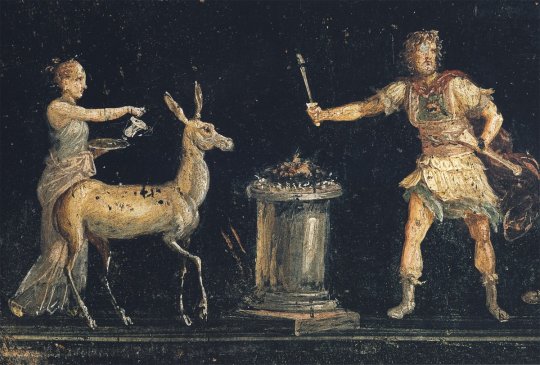
#witch mother#witch fire#witchblr#witch#witchcraft#traditional witch#traditional witchcraft#aradia#diana#witch trials#queen of elfame#baba yaga
81 notes
·
View notes